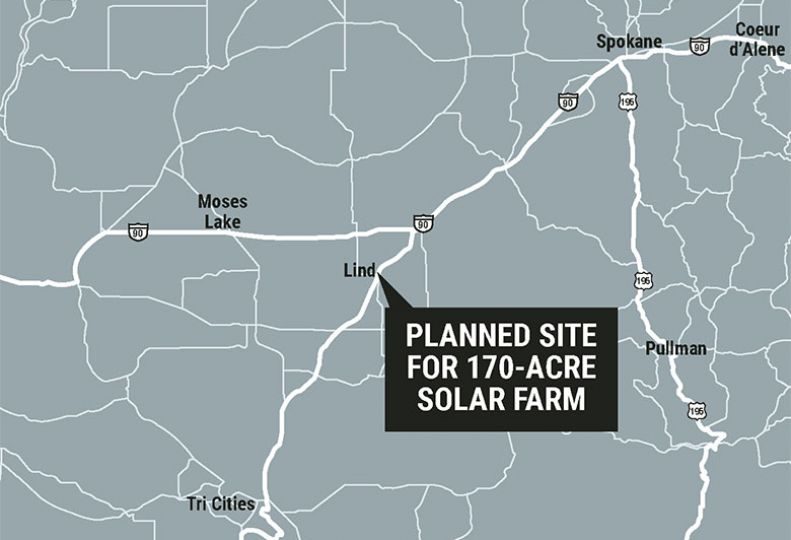
Home » Avista to debut Solar Select energy program
Avista to debut Solar Select energy program
Energy company developing shared facility for midsized, large commercial customers

May 10, 2018
Registration has started for Spokane-based Avista Utilities newest renewable energy program, Solar Select.
Marc Schaffner, renewable energy product manager for Avista, describes the program as a cost-effective structure designed to bring solar energy to the company’s medium- and large-sized commercial and industrial customers in Washington state.
“Solar Select is a voluntary shared program that functions similarly to our community solar project for residential customers,” he says. “It’s meant to benefit our larger commercial and industrial customers, helping them to meet their renewable energy goals.”
He says Avista has agreed to buy solar power from Strata Solar, a Chapel Hill, N.C., company that will construct a centralized solar production facility in Lind, Wash., some 75 miles southwest of Spokane.
Strata Solar will begin construction of the facility later this month, and the new facility is expected to be ready for commercial operations by late fall or mid-December.
Schaffner says the Solar Select facility site will include a solar array comprised of more than 81,000 solar panels located on 170 acres of land. The panels are expected to generate 48.5 million kilowatt hours of electricity annually, which is roughly about as much electricity as it takes to serve 4,000 homes.
The Solar Select program, which works in collaboration with solar energy project developer Strata Solar and the Washington State University Energy Program, enables participating customers to acquire solar electricity and the associated renewable energy certificates with no additional costs to their business.
“Because solar energy is more expensive to generate than regular power, Avista isn’t able to put it onto the grid at the same rate as other kinds of power the utility generates,” Schaffner says. “So, our first goal was to select a developer that could build a shared solar facility and corresponding power agreement that would enable us to reduce that cost for customers.”
Schaffner says Avista will buy the electricity generated by the array and sell it to 40 to 80 large commercial and industrial customers. A state tax incentive will offset the incremental cost of solar power and bring that cost in line with the utility’s existing rates for its large electric users. For the Solar Select project, the tax incentive is worth up to 6 cents per kilowatt-hour for a period of eight years.
“Without the tax incentive, customers would pay more for the Solar Select program,” he says. “With the incentive, they pay the same rate regardless of the energy source.”
The WSU Energy Program is a self-supported department within the university, that operates similarly to a consulting firm, providing energy services, products, education, and information to its customers. The department will be in charge of administering the tax incentive for Avista’s Solar Select program, under the category of shared commercial solar projects.
Schaffer says the Solar Select program only is available to commercial customers in Washington state currently.
“We’re not able to offer the program to our customers in Idaho, as their state doesn’t offer the same incentives,” he says.
Because the facility can generate a finite amount of power annually, Schaffner says that power will be divided between participating Solar Select customers, based on the amount of kilowatt hours they’ve applied for.
“Participating customers will identify one meter on their premises, through which a designated volume of kilowatt hours of solar power will be applied,” he says. “Enrollment will be conducted on a first-come, first-served basis. If their application qualifies for the program, they would then sign a service agreement with Avista.”
Prior to opening of the program’s registration period on May 1, Avista reached out to customers and provided informational webinars to help them learn more about how to participate.
Schaffner says opening registration for the program showed a diverse group of interested customers from industries including higher education, manufacturing, and retail.
“Our opening response has been good and really affirmed what we’d been hearing from customers about the need for access to programs like this,” he says. “We’re working through individual applications to ensure they meet the necessary qualifications, but we’re very pleased with the response so far and expect to receive more applications in the coming days.”
Schaffner says programs like Solar Select are important, because they provide companies with sustainable energy goals an easier, more cost-effective way to increase their use of renewable energy.
“Rather than taking on the work and cost associated with independently researching solar power and creating their own solar facility, customers have this turn-key option,” he says. “For businesses that have their own sustainable energy goals, it helps them to reach them more easily.”
Schaffner says Avista continues to seek ways to help customers achieve their renewable energy goals. One such Avista effort is its Electric Vehicle Service Equipment pilot program, which enables residential and commercial electric customers in Washington to get an electric vehicle charger installed at their home or business at a substantially reduced cost. Customers who have such electric vehicles can save money on fuel costs and vehicle maintenance, while reducing greenhouse gas emissions by 80 percent, he asserts.
He says the program is meant to help Avista better understand how electric vehicles will affect the power grid, and how to best serve customers as adoption of electric vehicles becomes more mainstream.
“It’s all about customer choice and how we can help them to meet their needs through our products,” says Schaffner. “Our goal with all of our renewable energy programs is to be able to offer them to as many different customers as possible.”
Avista Utilities is a division of Avista Corp. The company’s website lists it as providing electricity to nearly 340,000 customers and natural gas to about 300,000 customers across 30,000 square miles in Washington, Idaho, and Oregon.
Latest News Up Close Government
Related Articles
Related Products




